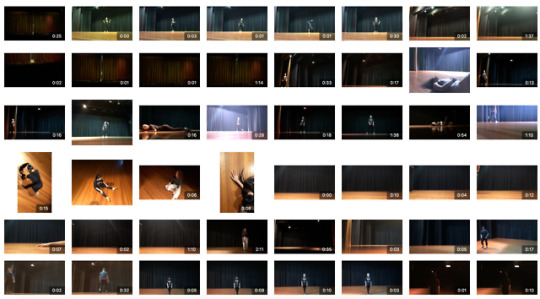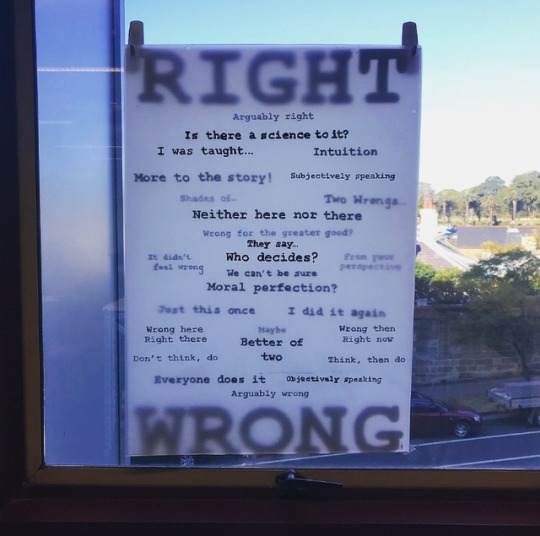Photo



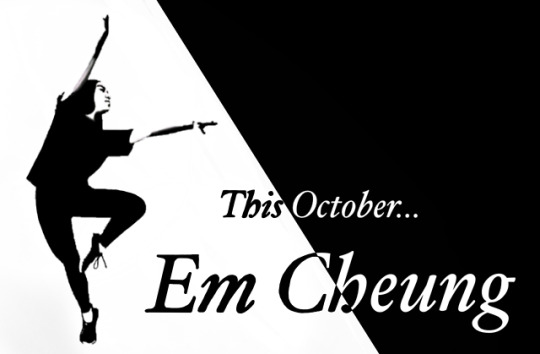
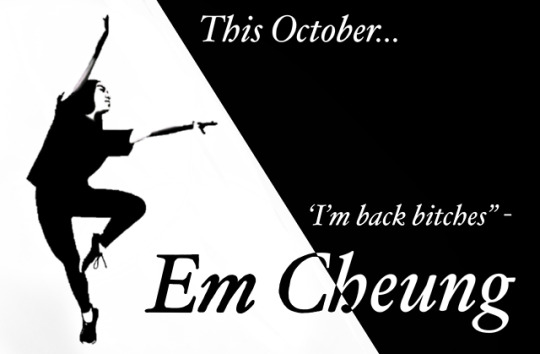
To contextualise our event, we created a simple graphic poster that ‘Em’ herself sends out at the start of the video, inviting everyone to her sensational solo performance. The black and white alongside ‘Em’s’ refined pose and elegant font establishes a setting that, when the glitch begins, is all the more disrupted and deconstructed. That this invite is sent out by Em, further plays into her experience with mental contagion and altercentric interference, where she believes her performance will be the paragon of lyrical and contemporary dance. The audience becomes holistically aware of this mental state through the outro, whereby she stands in front of the auditorium believing there is a resounding applaud when in fact it is silent and empty.
2 notes
·
View notes
Video
tumblr
Static, Noise, Interference, Glitch
2 notes
·
View notes
Photo

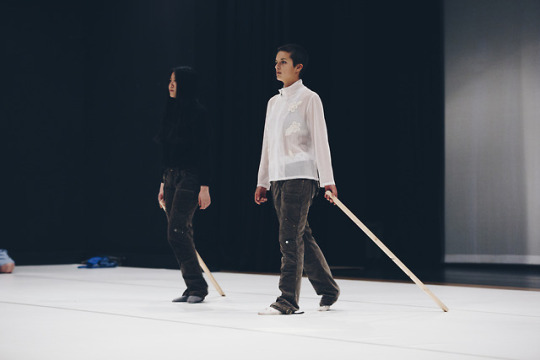
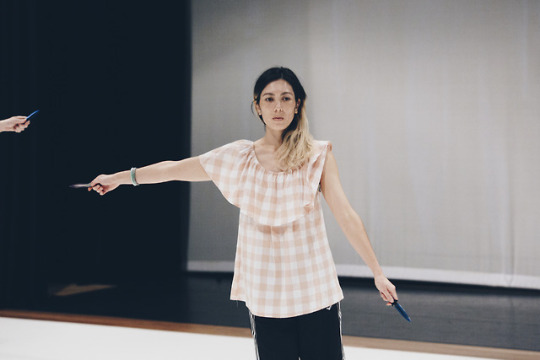
Angela Goh, Scum Ballet, 2017
Scum Ballet is a live performance and choreographed dance commissioned by the Campbelltown Arts Centre and explores the idea of femininity, violence, desire and power. Comprising of five performers, Scum Ballet uses props such as planks of wood and knives to examine the notion of fantasy as a weapon and the body as ammunition.
“We know what you did last summer, but last summer could be any summer because when knowledge is embodied it isn’t a matter of timing, but of feeling.” [1]
[1] Goh, A. (2017). Scum Ballet. Retrieved October 16, 2018, from http://angela-goh.com/works/scum-ballet/
2 notes
·
View notes
Text
ADAD Event - Research and Inspiration
Em, Seb and I decided to centre our ‘event’ on GLITCH, the class theme of week 10. Glitch Art is highly diverse, with artists expressing interference, malfunction and noise in expressively creative ways. The class slides were a great starting point, demonstrating the spectrum of possibility we had for this event through key ideas and references to artworks.
Key ideas from the class slides: - glitch as both an error in transmission and as a mode of contemporary art and design practice - the glitch has become a key concept of experimental sound and media arts - when something interferes in your work or when your work interferes in the world Artworks of interest from the slides: Yasunao Tone, Solo for Wounded CD (1997)
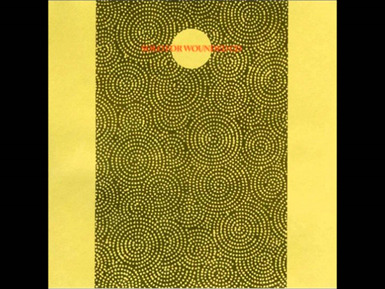
Michaela Davies, Attention is a Scarce Resource (2013)
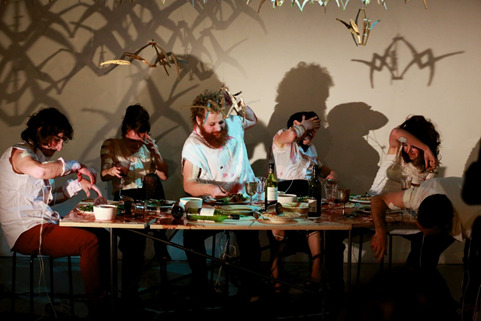
Kusum Normoyle, Accord with Air: Tjentiste (2012)
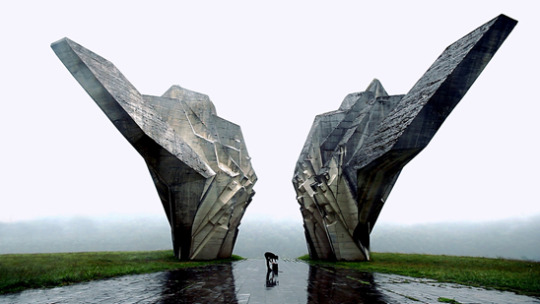
These artworks were an interest to our group because of their intensive interaction with sound and economies of motion and movement, or a lack thereof. Normoyle combines aspects of glitch in largely dissonant and initially jarring frequencies of sound alongside her dynamic and intensive movements. The audience also becomes aware of the environment she performs in, further emphasising to our group, the need for consideration and direction by all members (also collaborators). Viewing Attention is a Scarce Resource (2013) was also a key factor that informed the development of our event, a performance piece. The control imposed over the actor’s movements definitively emphasised a notion of ‘glitching’ the body – the body experiences a quick malfunction or error, jolting a limb in an unexpected direction or shaking uncontrollably. All of these elements, as well as discussions surrounding our own interpretations and preferences, led to the decision to imitate a long-awaited, solo dance performance by esteemed performer, Em Cheung. It is expected that the auditorium will fill out with people anticipating a lyrical masterpiece. And the beginning of the video suggests the manifestation of this event. Except the performance becomes a glitch, as Em’s performance is interrupted by a multitude of elements including Em herself. Altered sound demarcates the onset of the glitch and is followed through with a performance by all three of us (interrupting the notion of the ‘solo’ performance). Our movements set themselves against the consideration of lyrical and contemporary choreography, further glitching the event. Other relevant artworks which relate to the ideas underpinning our event: Motion Control (2008) by Liz Aggiss/Billy Cowie/David Anderson https://www.youtube.com/watch?time_continue=151&v=8ZNXk1JZems This video was particularly interesting to watch for our event. The haunting intro which leads to the equally haunting set in which the woman performs, accompanied by her jolted and jerked movements, is imitated in our event to varying degrees.
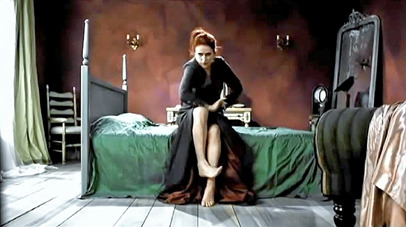
Dancing Glitch (2013) by Michael Betancourt https://www.youtube.com/watch?time_continue=127&v=0HbykeS3-vI
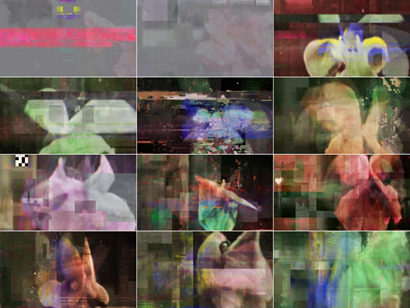
Scum Ballet (2017) by Angela Goh http://angela-goh.com/works/scum-ballet/ Scum Ballet is derived from distinct motivations relating to ‘power, desire, violence and tenderness’ (Goh, 2017), giving it its own agenda and artistic ownership. Our performance piece imitates the movement of Goh’s work, situating the body in a space in an unconventional way. However our motivations derive from a need to use that sporadic and impulsive movement as an expression of the glitch.
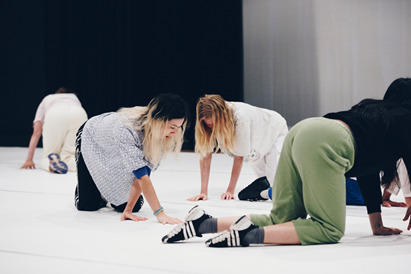
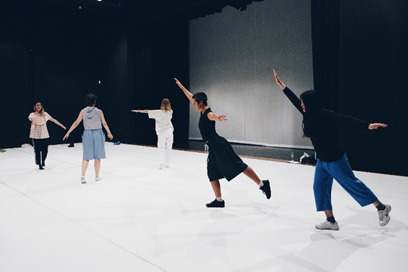
2 notes
·
View notes
Text
Assessment Two - Body of Work, Concept Statement, Bibliography
BODY OF WORK
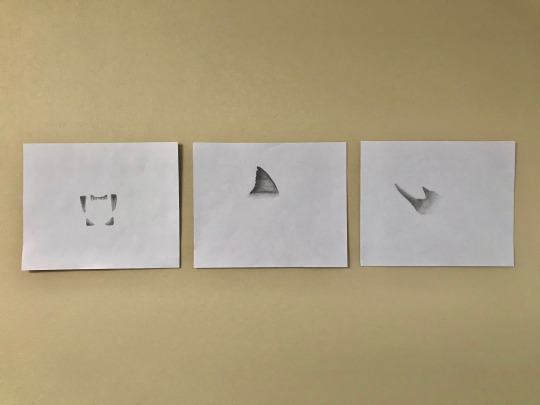
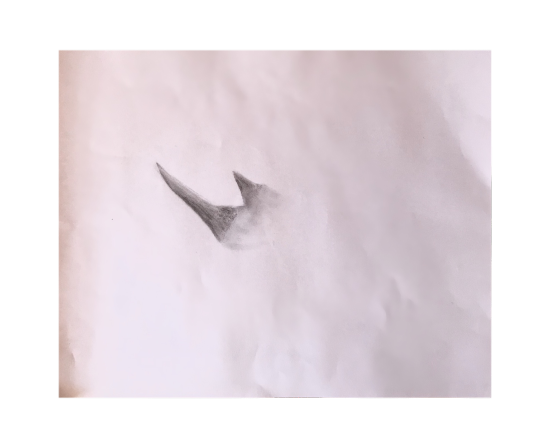
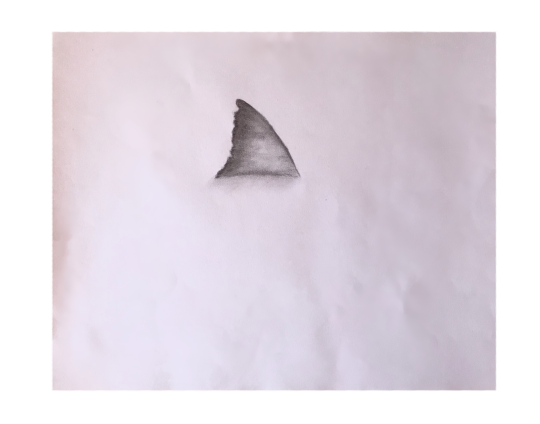
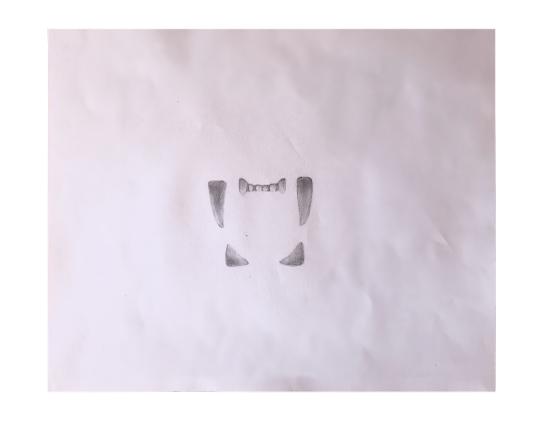
CONCEPT STATEMENT
Contemporary art and design often looks at the idea of constructed binaries, such as man/woman, soft/hard, straight/gay, dirty/clean, organic/synthetic. Considering the history of these ‘pairs’, how can art and design interrogate these binaries and offers new insights? The oeuvre of many contemporary artists derives from a desire to comment on issues central to the anthropomorphic community. These works often express an artist’s notion of wrong and right; the constructed binary humans use to distinguish between what rituals, behaviours and actions we morally accept and which we reject. In expressing what’s ‘right’ in an artwork, an artist also implicitly - or explicitly - denotes what is ‘wrong’, or vise versa. What occurs here, is the positioning of artist into a master-role whereby their understanding of the right and wrong binary is distinguished above that of the audience. Firstly, through the physical - the oeuvre - the artist is given a more dynamic and dominant platform for expression, therein privileging their viewpoint. Secondly, implicit in the position of audience, is a role of reaction and response - the engagement is directed first and foremost by the artist. This notion of privileging one, or a collective perspective, on wrong or right is reflected in quotidian life - social trends, governing parties, legal systems etc. The small-scale body of work presented attempts to subvert this distinctive binary of wrong and right, and instead privilege the notion of individualistic values and principles, comparable to a levelled spectrum rather than a two fold complex. To offer this insight into the binary of right and wrong, this artwork requires a case study depicted in such a manner, both in the body of work and in the statement, that positions me as the artist and my respective audience on a platform of equal authority. A global practice which manifests in different ways and which serves as the case study to inform this body of work, is the commodification of an animal’s singular or few body parts, achieved through hunting and/or poaching. For example, the practice of shark finning in China, whereby a shark’s fin is severed from the body by fishermen to be traded at the marketplace, or sold in a restaurant in shark fin soup as a cultural delicacy, entails the commodification of the shark fin - the rest of the body is typically discarded back into the ocean by fishermen so as to avoid declaring the full animal at port. Other body parts delineated in this body of work include the rhinoceros horn, the object of a pervading trade in predominantly South Africa, and the tiger’s teeth, sold as an item of status or of traditional medicines in Asia - other parts of a tiger are singularly sold on the black market too. The composition of the artwork is so that an artistic inflection of opinion is not discernable. The three white pieces of sketch paper provide a neutral background upon which to draw. Drawn on each page is a singular body part, sans the whole body or a distinctive setting. In not emphasising these, I inhibit the contextualisation of my personal opinion and belief regarding the case study. Each body part is depicted in grey-scale. This is due to the innate effect of colour on psychological and emotive responses. Overall, a space of levelled engagement is fostered, whereby artist and audience both have the same capacity for realising and expressing one’s opinion. The audience is allowed to react and respond freely, and aren’t confined to any interpretative trajectory given through artistic direction. Engagement with the work is enhanced by this degree of artistic neutralism, and from the need for the audience to visualise further. Artistic neutralism enhances the engagement with the drawings because the audience has to visualise further and consider all aspects of the objectively outline case study. One audience member may be attracted to the shark fin as a mark of holistic culture while another may perceive the initial act of severing the shark’s fin as ecologically detrimental. Another may consider the culture in and among the fishing industry. The range of possibilities derived from this body of work is what fosters the aforementioned spectrum of individualistic values, ethics and principles.
BIBLIOGRAPHY
Christy, B. (2016, October). Special Investigation: Inside the Deadly Rhino Horn Trade. Retrieved from National Geographic: https://www.nationalgeographic.com/magazine/2016/10/dark-world-of-the-rhino-horn-trade/
Elephant Action League. (n.d.). FLASH UPDATE FROM THE FIELD: CHINESE STILL DEMANDING TIGER TEETH, PRICES STILL HIGH. Retrieved from Elephant Action League: https://elephantleague.org/china-tiger-teeth/
Fairclough, C. (2013, August). Shark Finning: Sharks Turned Prey. Retrieved from Ocean Find Your Blue: https://ocean.si.edu/ocean-life/sharks-rays/shark-finning-sharks-turned-prey
Fieldstadt, E. (2015, July 17). Wildlife Poaching: 4 Reasons Why You Should Care About the Issue. Retrieved September 13, 2018, from NBC News: https://www.nbcnews.com/news/africa/wildlife-poaching-brings-unimaginable-consequences-n391976
Fisher, A. (2018, June 1). As Tigers Become Rarer, Poachers Are Targeting Lions. Retrieved from National Geographic: https://news.nationalgeographic.com/2018/06/wildlife-watch-illegal-trade-lions-teeth-claws-poaching/
Guynup, S. (2014, February 12). Illegal Tiger Trade: Why Tigers Are Walking Gold. Retrieved from National Geographic: https://blog.nationalgeographic.org/2014/02/12/illegal-tiger-trade-why-tigers-are-walking-gold/
Khadka, N. S. (2017, July 18). Lion parts 'sold as fake tiger products' in Asia. Retrieved from BBC News: https://www.bbc.com/news/world-africa-40643533
National Geographic. (2013, March 1). 100 Million Sharks Killed Every Year, Study Shows On Eve of International Conference on Shark Protection. Retrieved from National Geographic: https://www.nationalgeographic.com/people-and-culture/onward/2013/03/01/100-million-sharks-killed-every-year-study-shows-on-eve-of-international-conference-on-shark-protection/
Pleasant, A. (2017, December 6). Artists as Activists: Pursuing Social Justice. Retrieved from Huffington Post: https://www.huffingtonpost.com/amy-pleasant/artists-as-activists-purs_b_11783614.html
Rigoulet, J. (2017, April 21). Why is the Illicit Rhino Horn Trade Escalating? Retrieved from The Conversation: https://theconversation.com/why-is-the-illicit-rhino-horn-trade-escalating-76265
Worm, B., Davis, B., Kettemer, L., A, W.-P. C., Chapman, D., Heithaus, M. R., . . . Gruber, S. H. (2013). Global Catches, Exploitation Rates, and Rebuilding Options for Sharks. Marine Policy, 194-204.
0 notes
Text
Progress Progress Progress - Finalising the Project
My assessment one and two are inspired by question FOUR on binaries; I specified this further with a focus on the enduring binary of wrong and right. My assessment one poster encompassed a very broad understanding of how we interrogate and challenge this binary - it denoted that there are multiple complementary, as well as very conflicting, elements which create a middle ground in right and wrong. For assessment two I decided that a case study was needed to form and develop my idea further.
My initial interest area was the environment and humankind’s relationship with it. While I wasn’t very educated in this area, I also adopted a mindset from the beginning that privileged the environment and situated humans in the oppressive master role. This mindset was present in all early experimentations and began to clearly conform to an idea of what was right and what was wrong - the structure I am attempting to interrogate and subvert.
For example, my first draft project, as outlined in a previous post, was focused on a comparative work that depicted acts of animal cruelty next to imagery of humans being treated in a like manner. In an attempt to communicate the practice of poaching and hunting animals for the commodification of singular body parts - through drawing a shark fin, rhinoceros nose and tiger teeth - I also injected a strong oppositional perspective by drawing human body parts alongside them - a human nose, arm and teeth. This was as if to say, ‘We would not sell human body parts like this, and for such trivial matters like a display of wealth and prestige, so why do we participate in a culture that subjects animals to such treatment?’. I was evidently stating an opinion of what was right and wrong.
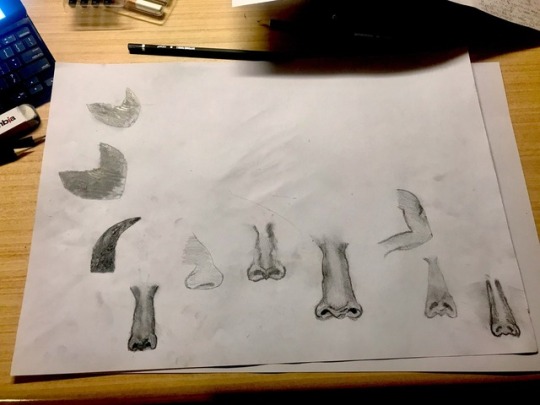

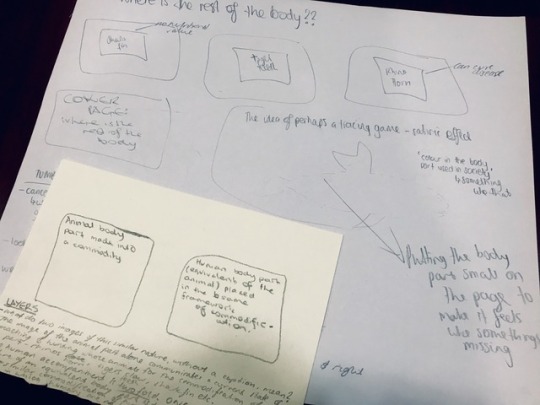
Except this was not, I’ve realised, how I want to interpret and answer the question on binaries.
‘Contemporary art and design often looks at the ideas of binaries’ is part of the question I wanted to highlight in particular. This is because it suggests that the artist/designer proffers one aspect of a binary over the other in their oeuvres. My assessment one poster made an attempt to play against this by highlighting the two in equal measures by writing ‘Wrong’ and ‘Right’ at an equal scale before then highlighting the middle ground of various complementary, as well as conflicting, elements that subvert the fixed and definitive binary. I believe that choosing a specific case study for assessment two is has made it challenging in regards to cultivating objectivity in my assessment two artwork and concept statement.
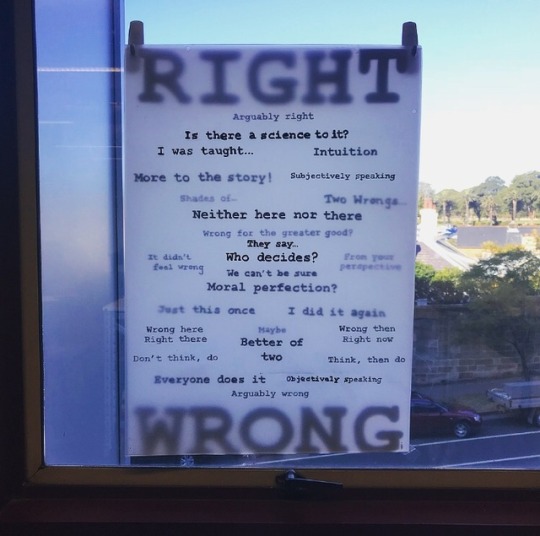
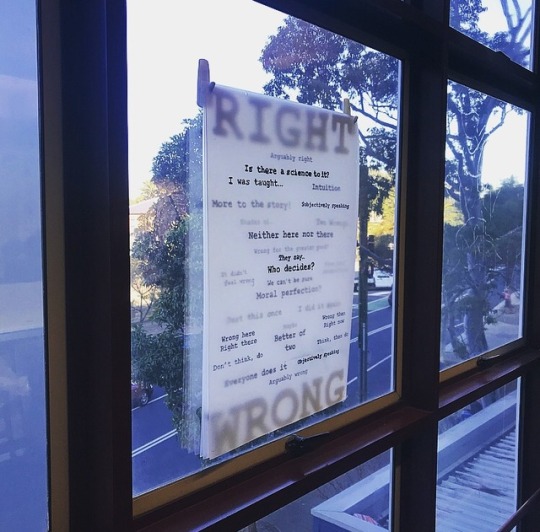
The reason why I want to exclude my opinion from this work is so to proffer a new way of depicting the right or wrong binary in art and design, and to question its value altogether.
The way this will be achieved;
My design will include a body of work - three pieces specifically. Each encompasses a depiction of an animal’s singular body part that has been commodified in some society, community or culture around the world. The body parts are, as delineated before, a sharks fin, a rhinoceros horn and a tiger’s teeth. Each will be drawn in grey scale on a white piece of paper; there will be no other drawn objects or scenes. The reason I do this is because I want to objectively depict a case study. By not using colour, and by drawing only the very core of this case - the body parts - I can’t contextualise through my own personal lens of wrong and right. In my presentation and in my concept statement, I will delineate the objective reality behind them - for example, I will outline how a shark is hunted or poached in the sea, has its fins cut off and the rest of its body more often than not disposed of back in the ocean. The fins collected are then sold at markets or to restaurants where they are used in shark fin soup, a delicacy especially in China and some other parts of Asia. The purpose of being so objective in my depictions and statement is to interrogate how artists and designers usually reinforce binaries by emphasising which ‘idea’ or ‘notion’ in any given binary that they prefer. This binary is then further fortified by the audience who usually either ‘agree’ or ‘disagree’, or ‘like’ and ‘dislike’ the conveyed opinion of the artist - they are affirming that there are two opposing sides. What I endeavour to do in this small-scale body of work is to situate myself, as the artist, with the audience. I won’t exploit the power-position of ‘artist’ to exert a specific opinion - rather I will interrogate the binary of wrong and right by privileging each and every possible opinion on a levelled platform.

As artist and audience join, we will all form opinions on the acts depicted, of which are informed by different elements and influences in our lives. HIGHLIGHT SOME ELEMENTS WRITTEN ON THE POSTER. Most people will use their opinions to assume what is right and wrong. Except that all of them can be dissimilar... and who can really decide which is the correct assumption? That there will be such disparity in opinion on this supposedly fixed binary of RIGHT and WRONG, is to question the value of it entirely. Thus the foundations of my major work return to the layers of meaning which form a grey area/middle ground in my assessment one.
I believe this major work thus interrogates the binary of WRONG and RIGHT by presenting a case study which can precipitate multiple ideas of what is right and wrong. A new insight then, is for artists and designers to deviate from standardised as well as personal expressions of a fixed, invariable ‘right’ and ‘wrong’, and instead cultivate a non-binary system of principles and ethics that are highly individualistic.
0 notes
Text
Further Progress - Assessment Two
Research into practices of animal cruelty has been an insightful and development process for me.
I found that I’ve been particularly drawn to industries of hunting and poaching, as they;
- Call attention to varying understandings of wrong and right, thus disrupting the fixed nature of binary oppositions.
- Highlight the middle ground between wrong and right assumed in complacency, indifference and desire.
I’ve decided that my project will be, similar to before, a series of comparative depictions. I’ve also decided to use this opportunity to experiment with drawing, a medium I’ve never used as a final product before. Given my lack of experience with drawing, I aim to make a strong statement, in which I consider multiple understandings of wrong and right in relation to practices of animal cruelty in hunting and poaching. Already, I have experienced an interrogation of my own participation in these practices through blatant indifference - I have found myself on the ‘middle-ground’ of this topic and others. Notions of a wrong and right are derived from opinion and belief... I had none of these regarding, for example, shark finning or poaching rhinoceroses for their horns.
My design encompasses a version of a post-human social structure in which the homosapien centre is dismantled - by illustrating comparative pictures of the human being subject to the same treatment as animals. This however, is offset by highlighting practices that support over-consumption, materialism and consumerism, therein subtly proffering a return to societies - especially Indigneous - who cultivated a relationship with the earth grounded in respect and mutualism.
I originally wanted to accompany my depictions with captions (as mentioned m previous post) but have decided not to in an attempt to keep the work relatively objective - I don’t wish to place the audience on a fixed trajectory to my opinion. In this way, the audience engages and derives from their viewing, a personal opinion.
A mind map below of my general thoughts:
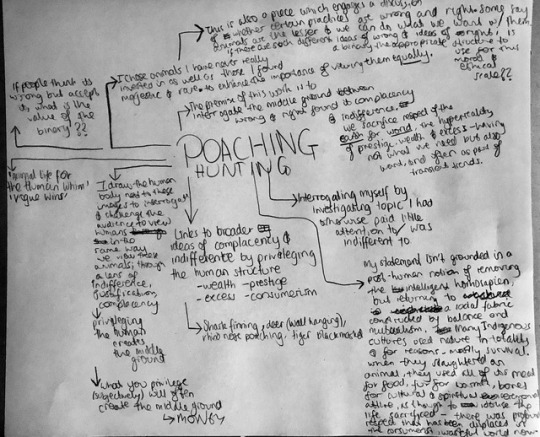
0 notes
Text
Case Study Focus for Assessment 2
For my assignment, I have been struggling in particular with finding a particular example to focus on for my assessment centred on the binary of RIGHT and WRONG. This is because I wanted to find a case study relevant to me that also interrogated my ideas of right and wrong.
A recurring issue that has occurred for me and forms as a currently topical and widespread conversation, is the question of animal rights and the subjugative relationship between human and animals. I want to create a satiric or comparative piece that delineates the moral compromise implicit in certain acts, processes and industry practices which clearly exploit animals for reasons of prestige, excess and overconsumption etc. Some of the practices outlined may be fur farming, selling body parts like a rhino nose or deer head for prestige, killing farm animals in access for overconsumption and consequential waste of meats, force breeding and so forth. Over the next couple of days, I will identity a select few issues I want to convey in my major work.
Furthermore, the notion of the middle ground I proffered in assessment one is prevalent in;
1. the very existence of these practices - we allow them to proliferate through justification and complacency - by assuming the middle ground of indifference
2. The way we treat animals would not, by most standards, be acceptable for human treatment. For a human to be treated like a commodity, identified through its singular body parts, is to be ‘treated like an animal’. This is indicative of another middle ground - different standards and ideas of right and wrong. WHO DECIDES?
Throughout my research and creation process, I believe I will find other points to make about the ‘middle ground’ or ‘silver-lining’ that challenges and interrogates the rigidity of the right and wrong binary.
The project I envision currently is a booklet of photographs. On each page there will be two comparative depictions - one with the accepted exploitative practice of the animal. On the right, will be a depiction of my various body parts - my hair, my leg, my lower stomach, my nose etc -, with various subtitles indicating assessment of quality and value as a product or commodity. For example, a picture of my thigh with the subtitle ‘Not juicy enough yet’, ‘Fat to meat ratio is out’ etc. I choose to capture my body and commodify it in order to interrogate my own perspective and complacent participation in these practices, particularly the consumption and overconsumption of meat. I also hope to immerse myself more fully in the exploitative practices against animals.
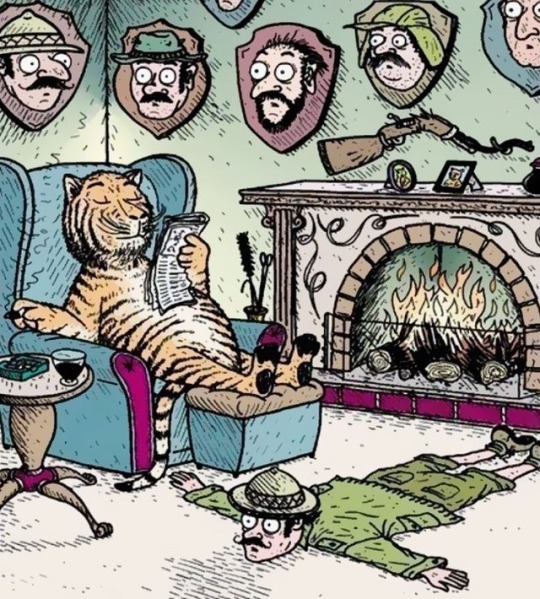
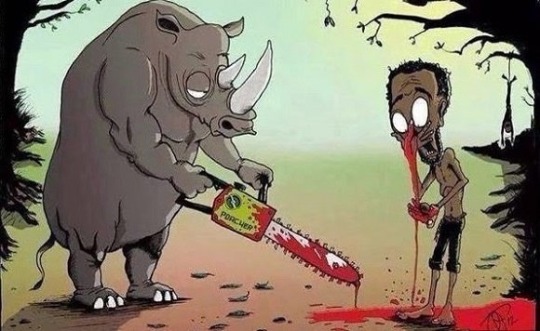
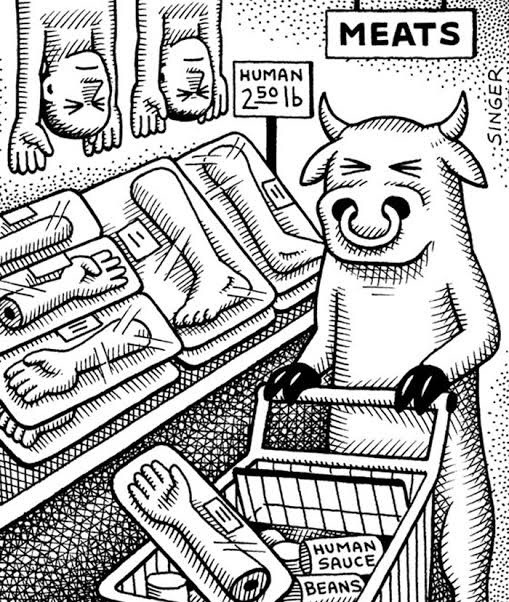


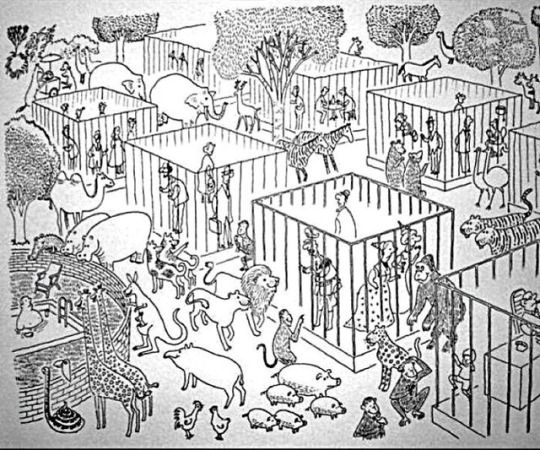
0 notes
Text
WK 6 - CONTEXT AND TIME
Having just presented my own poster design for assessment one, I found that the lecture slides from this week were particularly relevant. For my own design purposes I took down some notes:
- form linkages between your design and time, memory and cultural identity.
- understand the immediate, short term and long term effects of your work.
- are you fostering long-term designing?
- understand spatial presence and site specificity as a prominent element of your design work; one which can enhance the underpinning statement of the work.
- how does your work understand or represent time? Traditional linear time or an abstract conceptualisation of it?
In class we also conducted an experiment which featured students intervening in spaces. We had to utilise sensorial elements like sound, visuality etc, to alter the way a space is typically perceived and discuss the implications of this. For example, one group projected a toilet being flushed onto a normal desk chair, intimating the link between objects upon which we sit. The implications of this however, as highlighted in the class discussion, was in the interruption of the private and public spaces we associate with these two different chairs. People mentioned feelings a mix of wanting to see some ‘pee’ or flush the toilet while also feeling like they were encroaching upon a private moment.
My group projected an image of a forest onto the class room wall so as to disrupt the conventional physicality of the classroom - neutral colours and functional furniture. It creates a bridge between the man-made world and nature. Furthermore, we accompanied the projection with a static, wired audio. From my perspective, this served to reset the hierarchy of discourse within the classroom, whereby the teacher speaks at the students who then listen and memorise. To make it a more interactive work, our group of four also performed normative rituals in front of the projection like walking, reading, sitting or scrolling through the phone. This subsumed the classroom into a sphere of other familiar places, like the home, the park, the street where we informally learn new things everyday.
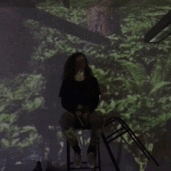
0 notes
Text
WK 5 CLASS - BODY AND POLITICS
In class, we discussed our normative routines and the way we situated our selves in daily life. As an experiment, we were sent out of class on a mini-experiment to compare how we enter into and move around the university campus. As a group of three, Em, Nelson and I discussed how we got to the uni (public transport for me and driving for them) and which side of a path we walked on (they naturally went to the left though didn’t have a preference and I commented on the hassle of groups who spread themselves across an entire walkway as opposed to splitting up and sticking to one side so that others can pass). We also walked to the Arthouse Kitchen where Nelson bought a ham and cheese croissant. I mentioned that I had never been there before and Nelson said he purchased food there often. We sat down and the conversation continued onto other topics where further differences or similarities in our habits and behaviours were highlighted. The exercise itself made me think about significant differences in seemingly universal actions or movements that people enact everyday.
Thinking about this experiment in relation to my upcoming major work made me think of normative situations where wrong and right could feature. A theme that came to mind was ‘Little White Lies’. These refer to the moral dilemmas we can encounter on a daily basis in which we seemingly find a grey, middle ground that interrogates fixed or assumed definitions of right and wrong. Mediums of interest to me could be a collection of short videography pieces, performance pieces or images. A potential issue with this theme could be that it is too broad and would leave the design piece without a specific statement or driving motivation. What would I really be saying or interrogating in my piece? I understand the idea itself still needs to be given a lot of thought as to where it could lead and how it could materialise as a major project.
A site I remember from my preliminary research for the poster in assessment one related to this idea:
https://greatergood.berkeley.edu/article/item/right_and_wrong_in_the_real_world
An excerpt from the website:
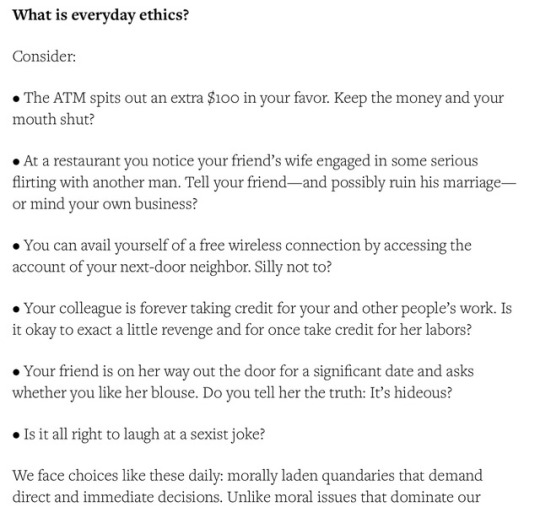
0 notes
Text
Concept Statement
My poster reflects a study and conceptualisation of question 4 - on interrogating and offering insights on representations of binary oppositions. My research process mainly entailed looking at interpretations of how binaries function, or don’t. Supporting arguments were made for technology, the functionality of which is grounded in binaries, and, more interestingly, earlier civilisations whose lifestyles encompassed the distinction between predator/non-predator, food/non-food etc. Media articles I read, such as ‘Right and Wrong in the Real World’ by Joshua Halberstam, suggested that the evolving human race perpetuated this model of thinking, even when complex matters of ethics, identity, culture, communities and more became prominent. An example of this I present is... ‘right’ versus ‘wrong’. In the globalised and technologically impacted society we inhabit, I find that this existing binary is one humans find hardest to reconcile with, especially in everyday life. I endeavour to interrogate the understanding of this binary, and any which relates to the fabric of human life (black/white, straight/gay, man/woman), by distorting the two-dimensional ‘wrong’ and ‘right’ terms with layered phrases and words of value and meaning.
Firstly, I selected clear A2 polypropylene sheets, six in total. These will be positioned behind each other to sustain the A2 structure while also intimating depth and layers of understanding - I want the form of my poster to be interrogating the two-dimensional binary process by subverting the traditional poster form of a 2D piece of writing material (cardboard, paper).
Layering the polypropylene engages the audience, communicating through the first sheet, which has more pronounced font, that there are initial and more obvious layers of thought which distort right and wrong, while communicating through those behind it, in which the thoughts and understandings become less comprehensible, that clear answers aren’t often plausible.
This is why I have positioned the overarching terms, ‘wrong’ and ‘right, on the last layer - to demonstrate that the binary is overshadowed by a vast amount of other considerations. The words are written in simple yet defined typography so as to assert my understanding more fully, and with varying sizes and levels of opacity, communicating that, in perceiving human life, we encounter strong, weak, complementary and yet sometimes contradictory possibilities.
The style of my poster was largely inspired by a combination of mindmapping, evident in Keg de Souza’s mind map poster ‘Common Knowledge and Learning Curves’, 2018, and Alison Knowles, ‘The House of Dust’, 1967.
1 note
·
View note
Text
Poster Revised
I’ve decided not to create the poster I described in the previous post. I’ve had many ideas pop up since deciding on my question... Ultimately, I wanted to keep the poster simple and the concept behind it strong because that is a realistic expectation for me as a design student only three weeks into her degree and with no prior design experience. That considered, I don’t feel like all of the elements of the poster I had described were simple or relevant in some ways to the core aspect of my idea. What I hope to create now is a little different and more simple. I believe it still maintains the notion of comprehending all matters in terms of layers of possibilities and realities as opposed to ‘this’ or ‘that’.
I will still use polypropylene. This poster will encompass six A2 polypropylene sheets, each one behind another to intimate varying depths of understanding and meaning - I want the form of my poster to interrogate the two-dimensional binary process by subverting the traditional poster form of a 2D piece of writing material (cardboard, paper).
Using the clear polypropylene is also representative. The first layer will reveal whatever is placed immediately behind it very clearly, but as another layer is added, and then another and another, the words (and the meanings behind them) become more indiscernible. This is representative of the distortion of binary thought processes, proffering instead that clear answers aren’t often plausible, and encompass a multitude of possibilities - some possibly more prominent than others.
To demonstrate my idea, I will use the common binary opposition of ‘wrong’ and ‘right’. There are prominent tensions involved in assuming what is wrong and what is right, and often a myriad of questions and definitions that distort the binary are implicated. The notion that the same situation can be viewed as wrong by one person and as right by another, and yet also as a combination of both by someone else, dismantles the idea of fixed meanings in binaries but also the certitude of only two possibilities. I will write in black, bold print, words and phrases associated with this process. They will fade in and out of clarity depending where they are situated, communicating that in navigating our perceptions, we encounter strong, weak, complimentary and yet sometimes contradictory possibilities.
Breaking down the poster:
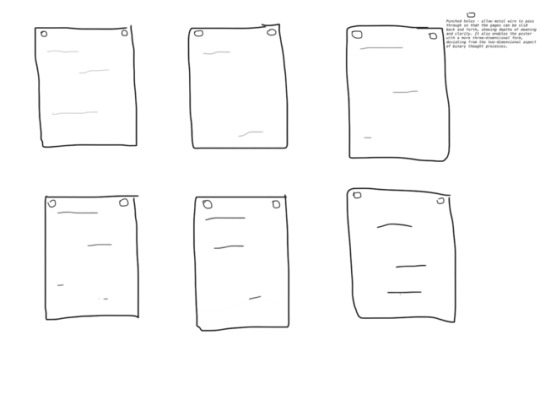
Materials:

1 note
·
View note
